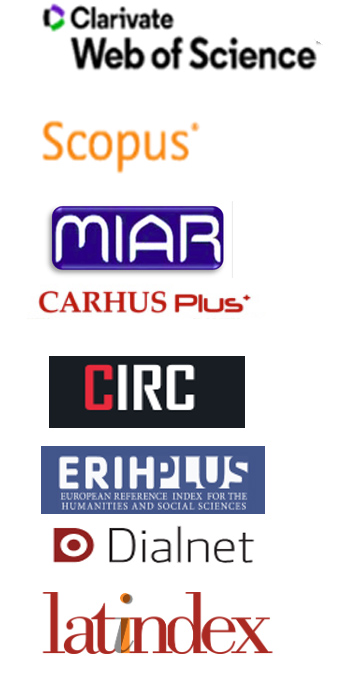A proposal of an appropriate terminology for digital prints based on the identification of their materials
Abstract
Digital printing in the arts became widespread by the end of the 20th century, so the materials and forms of creation can still be considered young although very heterogeneous. One of the biggest problems with this type of artworks is the lack of precise terminology. The processes are classified and named in very different ways, revealing a lack of objective criteria for their systematisation and generating a lack of understanding of the techniques used. Understanding the technologies, types of ink, substrates, and types of finishing and mounting systems helps to determine the techniques used with greater precision, and through the use of simple tools such as magnifying glasses or optical microscopes it is possible to find out their distinguishing peculiarities. Based on this information, it is possible to create clearer and more concise definitions, helping to establish the differentiating characteristics of digital prints and to highlight them as processes that reflect contemporaneity.
Downloads
References
ALCALÁ, J R. y ARIZA, J. (Coord.). (2004). Explorando el laberinto. Creación e investigación en torno a la gráfica digital a comienzos del siglo 21. Cuenca: Servicio de Publicaciones de la Universidad de Castilla-La Mancha.
AMERICAN INSTITUTE FOR CONSERVATION (2009). “Photographic Information Record”. https://www.culturalheritage.org/membership/groups-and-networks/photographic-materials-group/publications/photographic-information-record [consulta :1/9/2020].
ASH, N.; HOMOLKA, S. y LUSSIER, S. (2014). Descriptive Terminology for Works of Art on Paper. Guidelines for the accurate and consistent description of the materials and techniques of drawings, prints and collages. Filadelfia: Philadelphia Museum of Art.
BENJAMIN, W. (2010). La obra de arte en la época de su reproducción mecánica. Madrid: Casimiro.
BURGE, D.; NISHIMURA, D. y ESTRADA, M. (2008). “Summary of the DP3 Project Survey of Digital Print Experience within Libraries, Archives, and Museums”. En Archiving Conference, Berna: Society for Imaging Science and Technology, 133-136.
BURGE, D., NISHIMURA, D. y ESTRADA, M. (2009). “What do you mean when you say digital print?”, Archival Outlook, March/ April: 6-25.
CASTRO, K. (2005). Mapas invisibles para una gráfica electrónica: de la huella incisa al grabado con luz. Vigo: Universidade de Vigo.
EPSON EUROPE (2020). “Digigraphie by Epson”. https://www.digigraphie.com/en/index.htm [consulta: 4/10/2020].
GARCÍA, L. (2010). Conservación y Restauración de Arte Digital (Tesis Doctoral). Madrid: Universidad Europea de Madrid.
HERRÁEZ, J. A. (2017). Fundamentos de Conservación Preventiva. Madrid: Instituto del Patrimonio Cultural de España (IPCE).
IMAGE PERMANENCE INSTITUTE [IPI] (2007). “Digital Print Preservation Portal (DP3)”. http://www.dp3project.org/ [consulta: 15/10/2020].
IMAGE PERMANENCE INSTITUTE [IPI] (2009). “Graphics Atlas”. http://www.graphicsatlas.org/ [consulta: 11/10/2020].
INSÚA, L. (2003). La estampa digital. El grabado generado por ordenador (Tesis doctoral). Madrid: Universidad Complutense de Madrid.
JOHNSON, H. (2005). Mastering Digital Printing (2ª ed.). Boston: Thomson Course Technology.
JÜRGENS, M. (1999). Preservation of Ink Jet Hardcopies. Capstone Project, Cross-Disciplinary Studies. Rochester: Rochester Institute of Technology.
JÜRGENS, M.C. (2009). The digital print. Identification and Preservation. Los Angeles: The Getty Conservation Institute.
JÜRGENS, M. (2019). “The Eye”. http://the-eye.nl/ [consulta: 5/10/2020].
LAVÉDRINE, B; MONOD, S. y GANDOLFO, J.P. (2003). A Guide to Preventive Conservation of Photograph Collections. Los Angeles: Getty Conservation Institute.
MACÍAS, J. M. (2015). Arte gráfico digital. Propuestas para una creación mediante procesos híbridos (Tesis doctoral). Málaga: Universidad de Málaga.
MAYNÉS, P. (2012). “Terminología para los sistemas de producción de imagen múltiple”. En I Jornadas sobre Conservación Preventiva de Fotografía Contemporánea y Soportes Electrónicos, Madrid.
NOBLE, J. (1997). “Fractal attraction: Print meets computer”. En Computers and art, Mealing, S. (ed.). Exeter: Intellect Books, 77-95.
SHEPPARD, R. (2005). “What does archival really mean?”, Digital PhotoPro, 3 (3): 130.
WILHELM, H. (2006) “A 15-year history of digital printing technology and print permanence in the evolution of digital fine art photography - From 1991 to 2006”. En NIP22 & Digital Fabrication Conference. International Conference on Digital Printing Technologies. Springfield: The Society for Imaging Science and Technology, 308-315.
- Copyright and intellectual property belongs to author. Author guarantees editing and publishing rights to Ge-Conservación Journal, under a Creative Commons Attribution License. This license allows others to share the work with authorship and the original source of publication acknowledgement.
- Articles can be used for scientific and educational purposes but never for commercial use, being sanctioned by law.
- The whole content of the article is author’s responsibility.
- Ge-Conservación Journal and authors may establish additional agreements for non-exclusive distribution of the work version published at the Journal (for example, on institutional repositories or on a book) with acknowledgment of the original publication on this Journal.
- Author is allowed and encouraged to disseminate his works electronically (for example, on institutional repositories or on its own website) after being published on Ge-Conservación Journal. This will contribute for fruitful interchanges as also for wider and earlier citations of the author’s works.
- Author’s personal data will only be used for the Journal purposes and will not be given to others.









